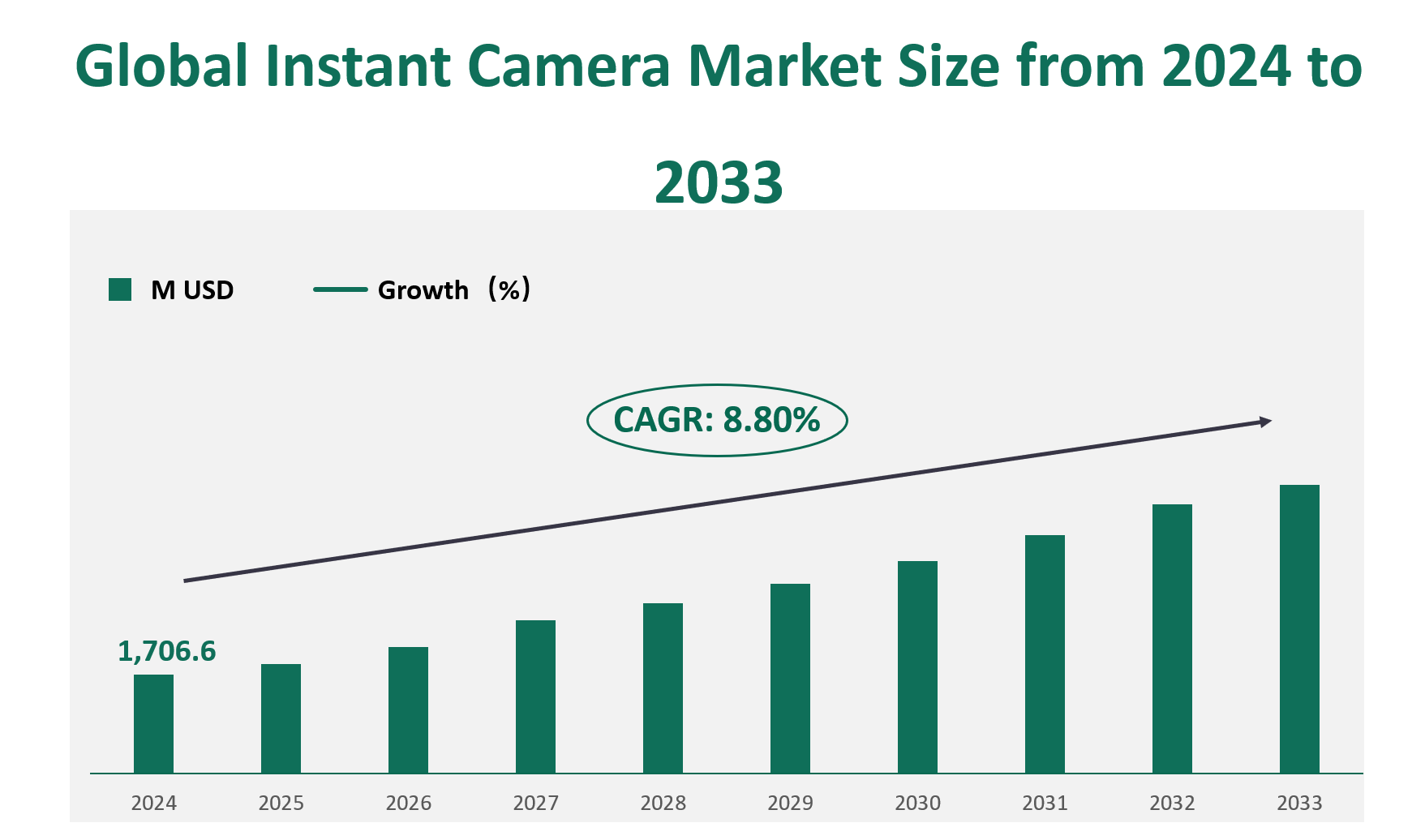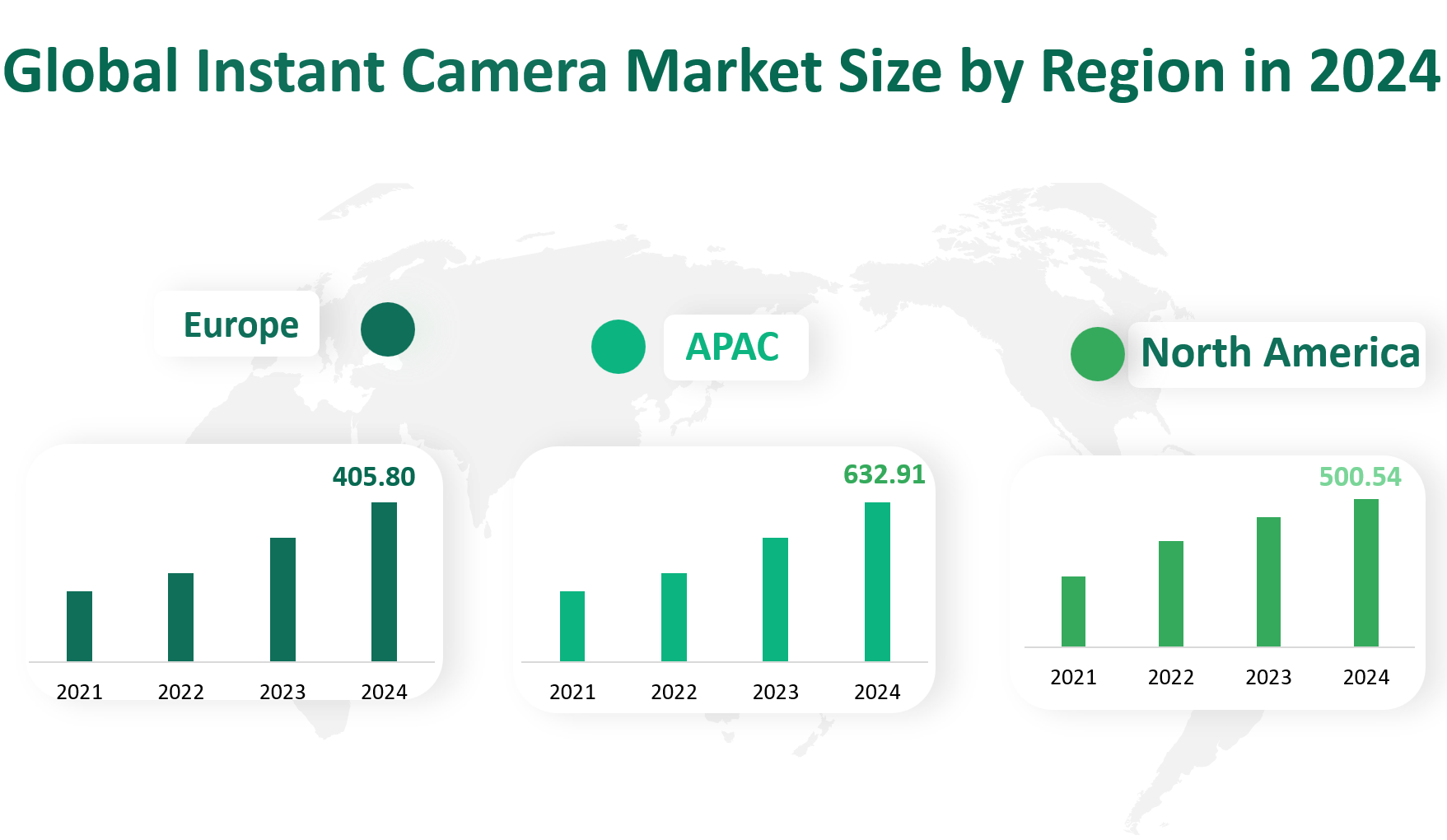1. Global Instant Camera Market Insight Analysis
In 2024, the global instant camera market value reached approximately $1,706.6 million USD, with a Compound Annual Growth Rate (CAGR) of 8.80% from 2024 to 2033.
An instant camera, also known as a Polaroid camera, is a type of camera that uses self-developing film to produce a chemically developed print shortly after the picture is taken. This unique feature sets instant cameras apart from traditional digital cameras and smartphones, offering users the nostalgic charm of immediate physical photos. Instant cameras can be categorized into two main types: non-retractable lenses instant cameras and retractable lenses instant cameras. Non-retractable lenses cameras are characterized by their fixed lens design, while retractable lenses cameras offer more flexibility and portability.
Figure Global Instant Camera Market Size (M USD) and CAGR (2024-2033)

2. Driving and Limiting Factors of Instant Camera Market Growth
The growth of the instant camera market is driven by several key factors. Firstly, the increasing demand for nostalgic and tangible experiences has led to a resurgence in the popularity of instant cameras. Consumers, particularly younger generations, are drawn to the unique and immediate nature of instant photography, which offers a tactile and memorable alternative to digital photos. Additionally, the integration of modern technology, such as digital features and mobile connectivity, has enhanced the functionality and appeal of instant cameras, making them more versatile and user-friendly.
Another driving factor is the growth of the tourism industry and the increasing number of photos taken worldwide. Instant cameras provide a convenient and stylish tool for travelers to capture and share their experiences immediately. The rise of social media platforms has also played a role in promoting the use of instant cameras, as users can easily share their physical photos online, creating a sense of exclusivity and authenticity.
However, the instant camera market also faces several limiting factors. One of the main challenges is the competition from alternative products, such as digital SLR cameras, smartphones, and other advanced imaging devices. These alternatives offer higher resolution, greater versatility, and the convenience of digital storage and sharing, which can overshadow the appeal of instant cameras. Additionally, the market faces challenges related to the availability and cost of instant film, which is essential for the operation of these cameras. The production and distribution of instant film are limited compared to digital media, which can restrict the market’s growth.
Furthermore, the market’s growth is also affected by the lack of support from upstream and downstream partners, especially for new entrants. Establishing a strong supply chain and distribution network can be challenging for new players, limiting their ability to compete effectively. The high initial investment required for production and marketing can also act as a barrier to entry for new companies.
3. Technology Innovation and Corporate Mergers and Acquisitions in Instant Camera Market
The instant camera market has seen significant technological innovations in recent years. Companies are continuously investing in research and development to enhance the features and performance of instant cameras. For example, Fujifilm Holdings Corporation has introduced advanced instant cameras with features such as macro mode, high-performance flash, and double exposure capabilities. These innovations not only improve the quality of instant photography but also expand the range of creative possibilities for users.
Corporate mergers and acquisitions have also played a crucial role in shaping the instant camera market. Major players such as Fujifilm Holdings Corporation and Polaroid have engaged in strategic partnerships and acquisitions to strengthen their market positions. For instance, Fujifilm’s acquisition of Hitachi’s diagnostic imaging equipment business highlights the company’s commitment to expanding its product portfolio and enhancing its technological capabilities.
4. Global Instant Camera Market Size by Type
The instant camera market is primarily segmented into two main product types: Non-retractable lenses instant camera and Retractable lenses instant camera.
Non-retractable lenses instant camera features lenses that cannot be retracted into the body of the camera. They are designed for simplicity and ease of use, making them ideal for consumers who prioritize portability and straightforward operation. These cameras typically come with fixed lenses that are permanently extended, allowing for quick and easy picture-taking. The revenue generated by non-retractable lenses instant cameras in 2024 is projected to be approximately $394.45 million.
Retractable lenses instant cameras offer a more advanced and versatile option. These cameras feature lenses that can be retracted into the body when not in use, providing better protection and a more compact form factor. This type is often preferred by enthusiasts and professionals who require higher image quality and additional features such as manual controls and interchangeable lenses. The revenue for retractable lenses instant cameras in 2024 is expected to reach approximately $1,312.15 million.
Table Global Instant Camera Market Size by Type in 2024
Market Size (M USD) 2024 | |
Non-retractable lenses instant camera | 394.45 |
Retractable lenses instant camera | 1312.15 |
5. Global Instant Camera Market Size by Application
The instant camera market is also segmented based on its applications, primarily divided into Commercial Use and Private Use.
Commercial use of instant cameras involves applications where the cameras are employed for business purposes. This includes rental services, event photography, promotional activities, and other commercial endeavors where instant photography is required. These applications often demand higher durability, reliability, and advanced features to meet professional standards. The market value for commercial use of instant cameras in 2024 is projected to be approximately $284.03 million.
Private use of instant cameras refers to personal applications where individuals purchase and use these cameras for their own enjoyment. This includes taking photos during vacations, parties, and other personal events. The appeal of instant cameras for private use lies in their ability to provide immediate tangible memories. The market value for private use of instant cameras in 2024 is expected to be approximately $1,422.57 million.
Table Global Instant Camera Market Size by Application in 2024
Application | Market Size (M USD) 2024 |
Commercial Use | 284.03 |
Private Use | 1422.57 |
6. Global Instant Camera Market by Top Regions
North America remains a significant player in the global instant camera market, with a market value of $ 500.54 million USD in 2024. The region’s strong market position is attributed to the presence of major players such as Fujifilm Holdings Corporation and Polaroid, which have a substantial market share. The United States, in particular, is the largest market within North America, driven by consumer demand for high-quality instant cameras and the integration of advanced features such as digital connectivity and mobile app integration.
Europe is another major market for instant cameras, with a market value of $405.80 million USD in 2024. The region’s market is characterized by a diverse range of consumer preferences and a strong presence of both local and international brands. Germany, the UK, and France are the leading markets within Europe, contributing significantly to the overall regional revenue.
The Asia-Pacific region is the largest market for instant cameras globally, with a market value of $632.91 million USD in 2024. This region’s dominance is due to the rapid growth of the consumer market, particularly in countries such as China, Japan, and South Korea. These countries have a high demand for instant cameras, driven by the growing middle class, increasing disposable income, and a strong interest in photography and technology.
South America’s instant camera market is valued at $113.45 million USD in 2024. Brazil and Argentina are the key markets within this region, contributing significantly to the overall revenue.
The Middle East and Africa region has a market value of $53.89 million USD in 2024. The region’s market is driven by the growing tourism industry and the increasing demand for instant cameras in countries such as Saudi Arabia, Turkey, and Egypt.
Figure Global Instant Camera Market Size by Region in 2024

7. Global Instant Camera Market Analysis by Major Players
7.1 Fujifilm Holdings Corporation:
Introduction and Business Overview: Fujifilm Holdings Corporation, established in 1934, is a global leader in imaging solutions. The company operates worldwide and offers a wide range of products, including digital cameras, instant cameras, and film. Fujifilm is known for its innovative and high-quality products, which cater to both professional photographers and casual users.
Products Offered: Fujifilm’s instant camera lineup includes the popular instax series, which features models like the instax mini 90 and instax SQ1. These cameras are known for their compact design, ease of use, and high-quality prints.
7.2 Polaroid:
Introduction and Business Overview: Polaroid, founded in 1937, is a well-known brand in the instant photography market. The company has a rich history of innovation and is synonymous with instant cameras. Polaroid offers a variety of instant cameras and films, catering to both commercial and private users.
Products Offered: Polaroid’s product range includes the OneStep 2, i-Type cameras, and various instant film formats. These cameras are designed for simplicity and ease of use, making them popular among casual users.
7.3 Eastman Kodak Company:
Introduction and Business Overview: Established in 1898, Eastman Kodak Company is a pioneering name in the photography industry. The company offers a range of imaging products, including instant cameras and films. Kodak’s instant cameras are known for their reliability and high-quality prints.
Products Offered: Kodak’s instant camera offerings include the KODAK Mini Shot Instant Camera, which combines instant printing with digital convenience. The camera features a 10-megapixel sensor, LCD viewfinder, and Bluetooth connectivity.

